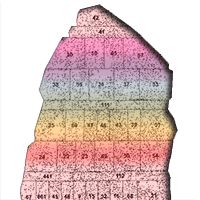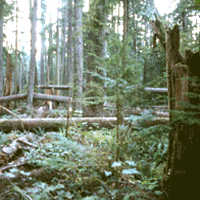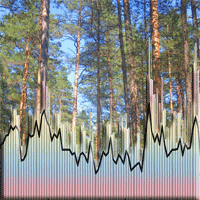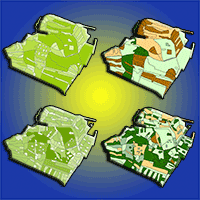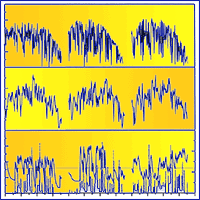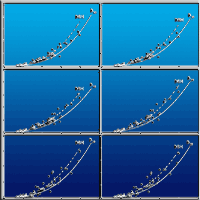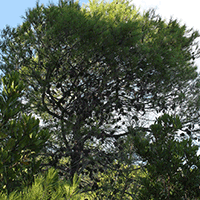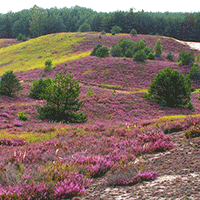
Differences in early dynamics and effects of slope aspect between naturally regenerated and planted Pinus sylvestris woodland on inland dunes in Poland
iForest - Biogeosciences and Forestry, Volume 9, Issue 6, Pages 875-882 (2016)
doi: https://doi.org/10.3832/ifor1728-009
Published: Jun 17, 2016 - Copyright © 2016 SISEF
Research Articles
Abstract
There is little knowledge of the effects of landform relief on early growth dynamics and competitive interactions of Pinus sylvestris (Scots pine) stands on inland dunes, which could potentially be substantial. The goal of this study was to examine and compare early dynamics (based on growth parameters and properties of the understorey vegetation) and the effects of slope aspect in naturally regenerated and pine-planted woodland on inland dunes in northern Poland. Growth parameters, tree density, and understorey vegetation were monitored on north- and south-facing slopes in a 26.3 ha post-fire area with natural secondary succession and eight even-aged pine-planted stands, 5-34 years old. Clear differences were detected between the woodland types, in both growth parameters of pines with similar ages and effects of slope aspect on the pines. In the natural regeneration area north-facing slopes provided favorable conditions for natural encroachment by pines. Tree density was higher, and the pines were taller and thicker, on north-facing than on south-facing slopes. In contrast, in the pine-planted area pines were larger on south-facing slopes, although growth conditions were less favorable than on north-facing slopes. However, in the pine-planted area the north-facing slopes had significantly higher herb cover, dominated by Deschampsia flexuosa, indicating that even the presence of a relatively low grass species can impede early growth of Scots pine. The understorey species composition differed in the natural regeneration area, being dominated by Calluna vulgaris on north-facing slopes and Corynephorus canescens on south-facing slopes. The results reveal that interactions between landform, natural dynamics, planting practices, and competitive interactions in woodlands on inland dunes are complex, and should be considered in efforts to manage them efficiently.
Keywords
Scots Pine, Growth Dynamics, Dunes, Slope Aspect, Forest Succession, Pine Plantations, Sandy Areas, Podzols
Authors’ Info
Authors’ address
Department of Soil Science and Landscape Management, Nicolaus Copernicus University, Lwowska 1, 87-100 Torun (Poland)
Corresponding author
Paper Info
Citation
Sewerniak P (2016). Differences in early dynamics and effects of slope aspect between naturally regenerated and planted Pinus sylvestris woodland on inland dunes in Poland. iForest 9: 875-882. - doi: 10.3832/ifor1728-009
Academic Editor
Paola Mairota
Paper history
Received: Jun 02, 2015
Accepted: Mar 01, 2016
First online: Jun 17, 2016
Publication Date: Dec 14, 2016
Publication Time: 3.60 months
Copyright Information
© SISEF - The Italian Society of Silviculture and Forest Ecology 2016
Open Access
This article is distributed under the terms of the Creative Commons Attribution-Non Commercial 4.0 International (https://creativecommons.org/licenses/by-nc/4.0/), which permits unrestricted use, distribution, and reproduction in any medium, provided you give appropriate credit to the original author(s) and the source, provide a link to the Creative Commons license, and indicate if changes were made.
Web Metrics
Breakdown by View Type
Article Usage
Total Article Views: 51276
(from publication date up to now)
Breakdown by View Type
HTML Page Views: 43242
Abstract Page Views: 3072
PDF Downloads: 3604
Citation/Reference Downloads: 51
XML Downloads: 1307
Web Metrics
Days since publication: 3416
Overall contacts: 51276
Avg. contacts per week: 105.07
Citation Metrics
Article Citations
Article citations are based on data periodically collected from the Clarivate Web of Science web site
(last update: Mar 2025)
Total number of cites (since 2016): 12
Average cites per year: 1.20
Publication Metrics
by Dimensions ©
Articles citing this article
List of the papers citing this article based on CrossRef Cited-by.
References
Wplyw odleglosci od sciany drzewostanu na zageszczenie i przezywalnosć nalotów sosny zwyczajnej (Pinus sylvestris L.) na zrebach zupelnych i gniazdach [The influence of the distance from the stand edge wall on density and survival of Scots pine (Pinus sylvestris L.) seedlings on clear-cuts and gap cuts]. Sylwan 144: 27-42. [in Polish with English summary]
Gscholar
Gleby [Soils]. In: “Torun i jego okolice. Monografia przyrodnicza” [The city of Torun and the surroundings. Nature monograph] (Andrzejewski L, Weckwerth P, Burak S eds). Wydawnictwo UMK, Torun, Poland, pp. 153-176. [in Polish with English summary]
Gscholar
Pflanzensoziologie. Grundzüge der Vegatationskunde [Plant sociology: the study of plant communities]. Springer-Verlag, Wien-New York, pp. 865. [in German]
Gscholar
Dendrochronological analysis of three pine species used as pioneer species to stabilize the coastal dunes of the southern Baltic coast. Baltic Forestry 19: 226-235.
Gscholar
Wplyw wybranych czynników srodowiskowych na dynamike wkraczania swierka pospolitego na górnoreglowe polany popasterskie w Tatrach Polskich [The influence of some environmental factors on the succession dynamics of the Norway spruce on the upper montane belt glades excluded from pasturage in Polish Tatra Mountains]. Sylwan 148: 20-28. [in Polish with English summary]
Gscholar
Odnowienie naturalne na powierzchniach uszkodzonych przez pozar w Nadlesnictwie Rudy Raciborskie [Natural regeneration on post-fire area in Rudy Raciborskie Forest District]. Forest Research Papers 69: 255-264. [in Polish with English abstract]
Gscholar
Zeigerwerte von Pflanzen in Mitteleuropa [Ecological indicator values for plants of Central Europe]. Scripta Geobotanica 18: 1-262. [in German]
Gscholar
Wplyw wystawy na ksztaltowanie sie zasobnosci drzewostanów bukowych [Effect of exposition on yield of beech stands]. Sylwan 107: 35-50. [in Polish with English summary]
Gscholar
Wymian gazowa i gospodarka wodna [Gaseous exchange and water relations]. In: “Biologia sosny zwyczajnej” [Biology of Scots pine] (Bialobok S, Boratynski A, Bugala W eds). Institute of Dendrology of the Polish Academy of Sciences, Poznan-Kórnik, Poland, pp. 89-101. [in Polish with English summary]
Gscholar
Analiza wplywu pozaru na wybrane cechy fitocenozy boru sosnowego w aspekcie hodowli lasu [Analysis of effect of fire on some properties of pine forest phytocenosis in aspect of silviculture]. In: “Srodowiskowe skutki pozaru lasu” [Environmental effects of forest fire] (Sewerniak P, Gonet SS eds). Polskie Towarzystwo Substancji Humusowych, Wroclaw, Poland, pp. 83-107. [in Polish]
Gscholar
Ekspozycja stoków wydm w Kotlinie Torunskiej a wybrane elementy ekosystemu boru sosnowego - wstepne wyniki badan [Preliminary studies on the influence of dune-slope exposure on a pine forest ecosystem in the Torun Basin]. Forest Research Papers 72: 37-46. [in Polish with English summary]
Gscholar
Wplyw przygotowania gleby frezem lesnym na wzrost sadzonek sosny zwyczajnej w warunkach ubogich siedlisk Puszczy Bydgoskiej [Impact of soil preparation with rotary tiller on growth of Scots pine plants on poor sites of the Bydgoszcz Forest]. Sylwan 156: 871-880. [in Polish with English summary]
Gscholar
CANOCO reference manual and CanoDraw for Windows user’s guide: software for canonical community ordination (version 4.5). Microcomputer Power, Ithaca, USA, pp. 500.
Gscholar
Flora Europaea (2nd edn). Cambridge University Press, Cambridge, New York, Melbourne, Madrid, Cape Down, Singapore, São Paulo, Delhi, Dubai, Tokyo, Mexico City, pp. 581.
Gscholar
Klimat [Climate]. In: “Torun i jego okolice. Monografia przyrodnicza” [The city of Torun and the surroundings. Nature monograph] (Andrzejewski L, Weckwerth P, Burak S eds). Wydawnictwo UMK, Torun, Poland, pp. 99-128. [in Polish with English summary]
Gscholar
Zarys ekologii [Outline of the ecology]. In: “Brzozy. Betula L.” [Birches. Betula L.] (Bialobok S ed). Institute of Dendrology of the Polish Academy of Sciences, Warszawa-Poznan, Poland, pp. 265-291. [in Polish with English summary]
Gscholar

